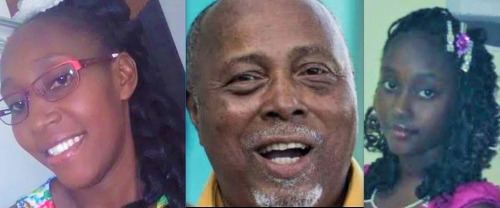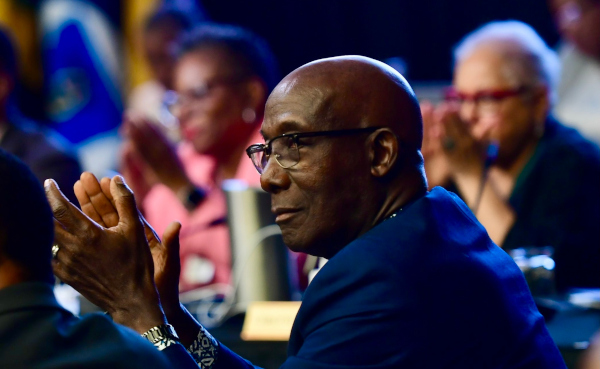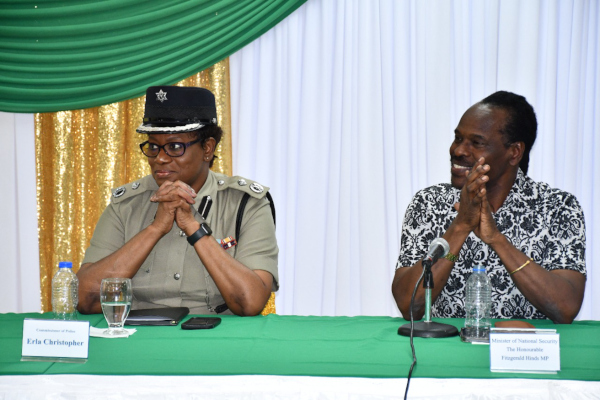“The police get more than 1,800 domestic violence reports annually and about 1,300 of these involve physical violence. This works out to an average of 25 per day. This means that, if the mandate being demanded by activists is met, at least 50 police officers will be expending at least 100 man-hours every day on such reports. Is this practical or even reasonable?
“Instead, it would be more effective to train the police to employ algorithmic methods to identify high-risk individuals when they make reports and prioritise those cases…”
The following Letter to the Editor, which seeks to use hard data to analyse domestic violence, was submitted to Wired868 by Kevin Baldeosingh.

Domestic violence, especially murder, understandably generates strong passions. But it is precisely for this reason that it is even more important to analyse the issue dispassionately, since responses and policies based on emotive arguments are likely to exacerbate rather than reduce the incidence of this kind of violence.
Passion (as well as politics), for example, impels unchallenged assertions that Trinidad and Tobago is experiencing an “epidemic” of violence against women. But do the statistics confirm this?
Last year, 52 women were murdered, 43 of them in domestic violence incidents. This is certainly a spike, since the average for the preceding decade was 26 domestic murders of women annually. At the same time, the murdered women in 2017 comprised 10 percent of all murders, which has been the pattern for the past 30 years.
The next important figure is the rate of domestic violence in general. Contrary to assertions that most women are cowering in fear of their partners, the data show that a minority of women in relationships experience physical violence. In respect of such violence, the Crime and Victimisation Survey (which surveys victims, not police reports) found that 12 percent of respondents reported such incidents. The Caribbean Human Development Report 2012 found that eight percent of both men and women experienced domestic violence.
The judiciary also reports that there are 10,000 applications for protection orders per year, which extrapolates to less than eight percent of all domestic relationships being sufficiently abusive to require such action.

Understanding this is important, since psychological research shows that people tend to act according to what they believe is the norm; thus, when the media and activists promulgate the false idea that domestic violence is widespread, this can actually cause more people to be abusive to their partners.
The main recommendation being put forward from various quarters is for the police to respond to ALL domestic violence reports. I am at a loss to understand exactly why since the same persons calling for this were involved in the passage of the Domestic Violence Act, which in Section 21 (1) already states that “A police officer shall respond to every complaint or report alleging domestic violence whether or not the person making the complaint or the report is the victim.”
So the real issue is the ratio of reports that police do respond to. This is an important data-point because it is only the failed responses which result in murder that come to public attention.
Those individuals and organisations who are calling for this measure without providing any empirical arguments are only demonstrating that they are pursuing a narrow agenda, as distinct from the common good. After all, if the police are mandated to respond to all domestic violence reports, it necessarily means that they must pick and choose among other crimes (such as rape and non-domestic assaults) since time and resources are limited.
The police get more than 1,800 domestic violence reports annually and about 1,300 of these involve physical violence. This works out to an average of 25 per day. This means that, if the mandate being demanded by activists is met, at least 50 police officers will be expending at least 100 man-hours every day on such reports. Is this practical or even reasonable?

Instead, it would be more effective to train the police to employ algorithmic methods to identify high-risk individuals when they make reports and prioritise those cases. Such algorithms will be based to a great extent on the likely profile of domestic murder victims. The data show that the most likely victims are between the ages of 25 to 29, are either Afro or mixed and reside in south Trinidad.
Finally, it is notable that, without exception, editorialists and commentators have studiously avoided saying what women can do, since it is not politically correct to view women as anything other than victims. However, any efficacious policy recommendations must necessarily start from the premise that women have agency. The victim perspective only reveals that virtue-signalling, ideology and even politics are being prioritised by the commentator over the actual reduction of domestic violence.
This is what got Prime Minister Keith Rowley in trouble for his common sense statement that women need to make better choices—although criticism of Dr Rowley for his self-serving and fallacious claim that policy measures cannot reduce domestic murder is not undeserved.
So it may well be the case that 41-year-old Abigail Jones-Chapman could have been saved had the police responded more effectively to her report of being threatened by a man she was involved with.
But it is also the case that if Chapman—the mother of three girls who, according to newspaper reports, had been estranged from her husband two years ago and was a regular church-goer—had made different choices, neither she nor any of the other murder victims would have been at risk.

Editor’s Note: Wired868 reserves the right to share opinions and views to which we do not necessarily subscribe and which may not at all be of a piece with our own opinions and views. Click HERE to view our editorial policy.
Want to share your thoughts with Wired868? Email us at editor@wired868.com.
Please keep your letter between 300 to 600 words and be sure to read it over first for typos and punctuation.
We don’t publish anonymously unless there is a good reason, such as an obvious threat of harassment or job loss.
 Wired868 Wired868 for smart sport news and opinion
Wired868 Wired868 for smart sport news and opinion







Woman is woman.
“The data show that the most likely victims are between the ages of 25 to 29, are either Afro or mixed and reside in south Trinidad.”.
Is this true, or is this the Baldeosingh’s usual drip-drip propaganda to paint the Indian white and the negro ugly?
Where are the stats for men murdered due to crimes of passion i.e. domestic violence? I’m actually curious.
Might be a different kind of emotion. Like envy.
Really would be interesting to break down murders into motives and see what we get.
Keron King what do you think?
HI Lasana Liburd regarding Alina Doodnath question this is the best I can do atm. From 2000-2013 there have been 329 DV related murders. 2001-2016 data says 87% of the offenders were male. I don’t have that type of info you seek as to the “motive” for the DV murders. The way the “motive” or probable cause data for murder is categorised atm, they don’t really collate that type of data. The categories are a bit larger: altercation, drug related, gang related, robbery, revenge, etc. Source: Official Reports to TTPS
generally speaking 72% of DV victims are women
Thanks Keron
Now here’s an article on predictive policing, utilising big data, tested in a big city environment – https://www.aclu.org/blog/privacy-technology/new-orleans-program-offers-lessons-pitfalls-predictive-policing
The Crime and Problem Analysis Branch of the TTPS staffed with civilians and police is supposed to do that. But the questions are whether the staff has the data to work with in the first place and whether they currently have the necessary intellectual capacity to do so.
But see, when the abuser is the police officer…
I dunno …. to see violent death as an appropriate outcome for someone making a bad relationship choice is kind of an extreme position….I could be wrong …
Tanya behave yourself
They don’t have a car or receipt books to do that. 🙁
Did he use the words ‘police” and ‘algorithms’ in the same sentence?
I wondered the same; in a country where it’s painful to see the multitude of errors on a traffic ticket!
Lmao
OMG …. this reminds me of that old Sprangalang joke, where he says – ‘police found a headless corpse in the cane fields, suicide is suspected, however homicide has not been ruled out”… ???
It was a poor ending I thought. As far as I know, the man never killed anyone before and the woman did everything I’d reasonably expect someone to do: she ended the relationship, she lived separately and she alerted the police.
I don’t know what other “choices” she might have made.
But there were many who defended the prime minister when he effectively said the same thing.
But, in T&T, wha good fuh the Chief never good fuh the apache. Wait and see!
She should have *seen* his potential to be abusive (probably through women’s intuition) from the time he approached her and said hello that first time.
Because there is a hard core group of people in the society who believe, no matter what the evidence to the contrary, no matter how much modern research and ways of thinking go against the myths, that somehow it is always a woman’s fault if she is physically harmed in some way, whether rape, assault, murder, etc … and unfortunately, in a place like TT, those kinds of people are in the majority, sooo you can see it’s overall not a pretty picture …
There are reasons the police can be held accountable. Failure to protect when there is a direct and imminent threat proves costly, time and again.
Fayola Bostic I totally get your point and I always preach to my female friends and family to not ignore that women’s intuition thing. However, as a man girl some of us can be deceitfully sweet, and say and do all the right things until it’s too late for the poor victim?
Funny thing about this particular situation is that this poor woman did — albeit at the end — see (and feel!! With the knife to her throat?) the danger…the cops let her down.
Hopefully this brings a change in how police respond to these reports…in spite of what Kevin says.
Tony, i can virtually guarantee that Fayola was being sarcastic. She has her own tasty brand of sarcasm. ?
Lasana Liburd Ok Lasana I totally missed it?
She’s cheeky like that.
I was actually about to ask that. Lol
Sorry. Total sarcasm. I need a sarcasm emoji. ?
Yeah, I know what you mean, some people use the eye role emoji or the small open triangle ^ ….
Tony Sinclair
Thank you very much for being that honest And Truthful:
“As a man … Dleceitfully sweet”
Did any of the papers carry specific details of the genesis and nature of the relationship? Without knowing what she knew of the man I’m not sure if pronouncements one way or the other can be made. But since we are speaking in absolutes, I suppose abusive men never give signs of their abusive tendencies before romantic entanglement, so there is that. Interestingly I know of men that spotted trouble in women and averted those disasters before anything resembling a relationship started.
Wow! All this rhetoric to end by simply blaming the victim? Well ok then.
Yeah, I’ve read a couple articles by him on this subject and that seems to be a recurring conclusion …
Tanya Carr Hmmm…I used to read him back in the day…don’t get me wrong he had some valid points and insights. However that last paragraph made me do a double-take! Hey at least we know exactly how he feels about those female victims.